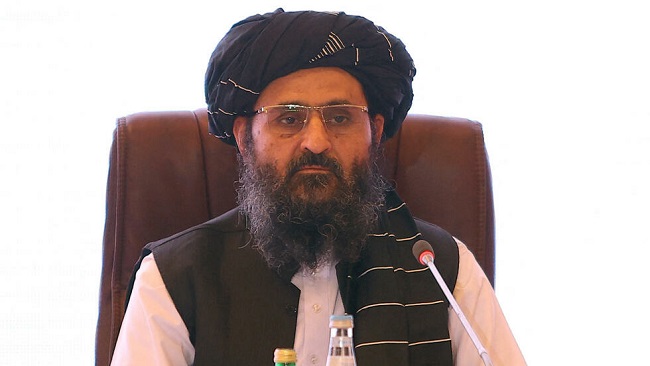From military commander to the Taliban’s top diplomat, Mullah Baradar’s ascent to power
The Taliban movement has always been headed by secretive characters, such as co-founder Mullah Omar or current supreme leader Baibatullah Akhunzada. As the insurgents completed their takeover of Afghanistan on Sunday, it is the group’s most public face, political chief Mullah Abdul Ghani Baradar, who appeared on social media to claim victory.
As Taliban fighters entered the Afghan capital of Kabul on August 15, a video of Mullah Abdul Ghani Baradar was posted on social media. Looking uneasy in front of the camera, the head of the Taliban’s political bureau delivered a short speech before the white flag of the Islamic Emirates of Afghanistan.
“We have reached a victory that wasn’t expected. We should show humility in front of Allah,” he said, expressing surprise by the lightning speed of Kabul’s fall.
“Now it is time to test and prove, now we have to show that we can serve our nation and ensure security and comfort of life,” added Baradar, as he urged his fighters to remain disciplined after taking control of the city.
Mullah Baradar to Taliban: “we have reached a victory that wasn’t expected…we should show humility in front of Allah…now it’s time of test — now it’s about how we serve and secure our people, and ensure their future/good life to best of ability”
But his words did not allay the fears of thousands of Afghans, who rushed the Kabul airport to escape the Taliban takeover.
Baradar, who has long served as the moderate face of the hardline Islamist group, is likely to return to power after a 20-year exile. His focus on garnering the support of the Afghan people harks back to his days as an insurgent military commander after US troops toppled the Taliban regime in 2001.
In 2009 Baradar ordered Taliban foot soldiers to carry a small handbook on how to win the hearts and minds of villagers, according to a New York Times report. This “code of conduct”, which included advice on how to avoid civilian casualties and to use suicide attacks sparsely to avoid a backlash, reflected the mullah’s political instincts that the Taliban had to increase popular support after their ruthless rule between 1996 and 2001.
The Taliban’s top diplomat
In 2010, Mullah Baradar was arrested in the southern Pakistani city of Karachi by agents belonging to the Inter-Services Intelligence, Pakistan’s powerful spy agency. He was photographed and paraded in chains in a bid to show Washington that Pakistani authorities took seriously their hunt for Taliban insurgents.
Baradar was released in 2018 when the US intensified its effort to leave Afghanistan. The cleric was flown to Qatar and became part of the Taliban’s negotiating team. He became one of the most well-known faces of the Taliban, focused on increasing the group’s diplomatic clout.
While the first Taliban regime (1996-2001) was recognised by only three countries at its peak – Pakistan, Saudia Arabia and the UAE – Baradar met with several key foreign dignitaries in a bid to secure global recognition. In September 2020, he held talks with then secretary of state Mike Pompeo, who was still hoping for a dignified US exit. Last month, he led a delegation to China to meet Chinese Foreign Minister Wang Yi, a visit that is now bearing fruit: Beijing said on Monday that it was looking forward to “friendly and cooperative” relations with the new Taliban regime.
First the Soviets, then the Americans
Behind the Taliban’s sleek diplomat is a battle-hardened military commander with strict religious convictions about how the world should be.
Born in 1968 in Weetmak village, Abdul Ghani Baradar grew up in the southern Afghan city of Kandahar, the birthplace of the Taliban movement. He fought during the 1979-1989 war to expel Soviet forces from Afghanistan, which attracted thousands of Islamist fighters from the world over and cemented relations between Afghan and foreign jihadists.
It was at this time that he met Mullah Omar, the cleric who lost one eye during the Soviet conflict and went on to become the Taliban’s supreme leader. Both were founding members of the hardline Islamist Taliban movement that emerged in the early 1990s from religious schools in southern Afghanistan and Afghan refugee camps in Pakistan. According to a BBC report, the two men may even have become brothers-in-law after Baradar married Mullah Omar’s sister.
Baradar has been an insurgent his whole adult life – except for the five years when the Taliban actually controlled Afghanistan. He was already a prominent Taliban figure and was Afghanistan’s deputy minister of defence when US forces invaded the country and toppled the regime in the wake of the 9/11 attacks. His significance remained after the Taliban went into hiding, and he is credited with masterminding several insurgent attacks before his 2010 arrest in Pakistan.
He was released in 2018, reportedly after Qatar sought his freedom as part of negotiations. The Taliban has maintained a political office in Doha since 2013.
Baradar subsequently helped lead the talks with the Trump administration that led to a February 29, 2020, agreement on a US troop withdrawal by May 1 the following year. Under the deal, the Taliban committed to preventing terrorist groups from setting up bases of operations in Afghanistan.
The agreement, signed by both US special envoy to Afghanistan Zalmay Khalilzad and Baradar, also called for an “intra-Afghan” dialogue to continue seeking a “permanent and comprehensive ceasefire”.
At the time, the Trump administration came under fire for conducting direct talks with the Taliban without representatives from the Afghan government. But now that the Taliban have definitively taken Kabul, it remains to be seen if the Islamist group remains committed to an “intra-Afghan” solution to bring lasting peace to the country.
Source: France 24





